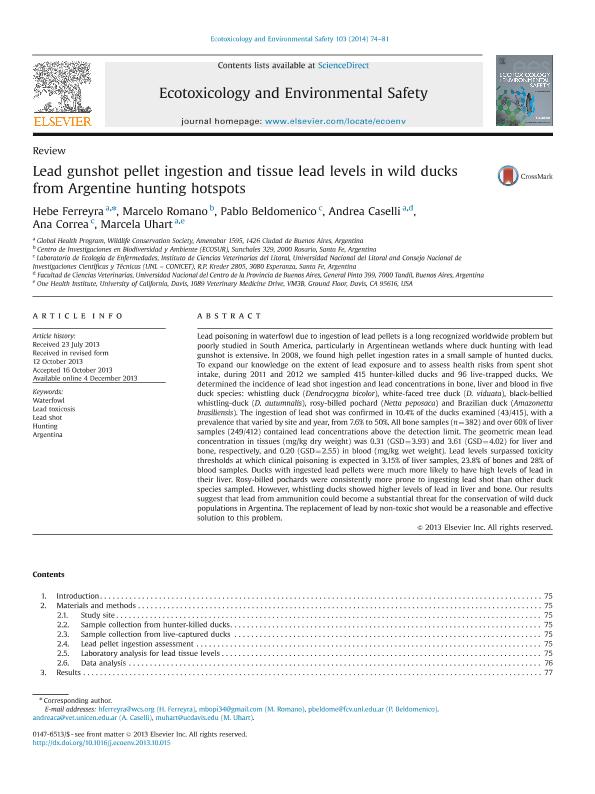Artículo
Lead gunshot pellet ingestion and tissue lead levels in wild ducks from Argentine hunting hotspots
Ferreyra, Hebe; Romano, Marcelo; Beldomenico, Pablo Martín ; Caselli, Andrea; Correa, Ana; Uhart, Marcela Maria
; Caselli, Andrea; Correa, Ana; Uhart, Marcela Maria
 ; Caselli, Andrea; Correa, Ana; Uhart, Marcela Maria
; Caselli, Andrea; Correa, Ana; Uhart, Marcela Maria
Fecha de publicación:
05/2014
Editorial:
Elsevier
Revista:
Ecotoxicology and Environmental Safety
ISSN:
0147-6513
Idioma:
Inglés
Tipo de recurso:
Artículo publicado
Clasificación temática:
Resumen
Lead poisoning in waterfowl due to ingestion of lead pellets is a long recognized worldwide problem but poorly studied in South America, particularly in Argentinean wetlands where duck hunting with lead gunshot is extensive. In 2008, we found high pellet ingestion rates in a small sample of hunted ducks. To expand our knowledge on the extent of lead exposure and to assess health risks from spent shot intake, during 2011 and 2012 we sampled 415 hunter-killed ducks and 96 live-trapped ducks. We determined the incidence of lead shot ingestion and lead concentrations in bone, liver and blood in five duck species: whistling duck (Dendrocygna bicolor), white-faced tree duck (D. viduata), black-bellied whistling-duck (D. autumnalis), rosy-billed pochard (Netta peposaca) and Brazilian duck (Amazonetta brasiliensis). The ingestion of lead shot was confirmed in 10.4% of the ducks examined (43/415), with a prevalence that varied by site and year, from 7.6% to 50%. All bone samples (n=382) and over 60% of liver samples (249/412) contained lead concentrations above the detection limit. The geometric mean lead concentration in tissues (mg/kg dry weight) was 0.31 (GSD=3.93) and 3.61 (GSD=4.02) for liver and bone, respectively, and 0.20 (GSD=2.55) in blood (mg/kg wet weight). Lead levels surpassed toxicity thresholds at which clinical poisoning is expected in 3.15% of liver samples, 23.8% of bones and 28% of blood samples. Ducks with ingested lead pellets were much more likely to have high levels of lead in their liver. Rosy-billed pochards were consistently more prone to ingesting lead shot than other duck species sampled. However, whistling ducks showed higher levels of lead in liver and bone. Our results suggest that lead from ammunition could become a substantial threat for the conservation of wild duck populations in Argentina. The replacement of lead by non-toxic shot would be a reasonable and effective solution to this problem.
Palabras clave:
Waterfowl
,
Lead Toxicosis
,
Lead Shot
,
Hunting
,
Argentina
Archivos asociados
Licencia
Identificadores
Colecciones
Articulos(ICIVET-LITORAL)
Articulos de INST. DE CIENCIAS VETERINARIAS DEL LITORAL
Articulos de INST. DE CIENCIAS VETERINARIAS DEL LITORAL
Citación
Ferreyra, Hebe; Romano, Marcelo; Beldomenico, Pablo Martín; Caselli, Andrea; Correa, Ana; et al.; Lead gunshot pellet ingestion and tissue lead levels in wild ducks from Argentine hunting hotspots; Elsevier; Ecotoxicology and Environmental Safety; 103; 5-2014; 74-81
Compartir
Altmétricas



